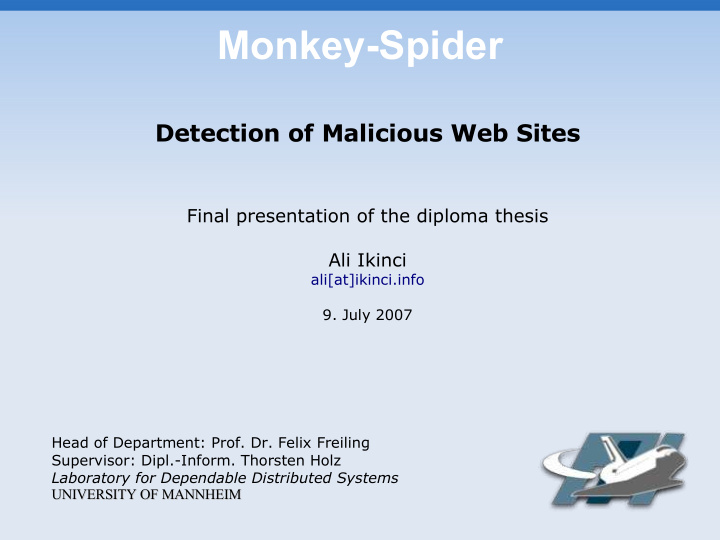



Monkey-Spider Detection of Malicious Web Sites Final presentation of the diploma thesis Ali Ikinci ali[at]ikinci.info 9. July 2007 Head of Department: Prof. Dr. Felix Freiling Supervisor: Dipl.-Inform. Thorsten Holz Laboratory for Dependable Distributed Systems UNIVERSITY OF MANNHEIM UNIVERSITY OF MANNHEIM
Outline Problem and challenge Simplified architecture Requirements analysis Honeypots vs. honeyclients Monkey-Spider architecture Limitations Preliminary results Key Findings
Problem Client side attacks are on the rise Many abuses of the Internet [1][2][3] No comprehensive and free database of threats on the Internet HoneyMonkey [4] SiteAdvisor [5] The Monkey-Spider 3
A sample SiteAdvisor site report The Monkey-Spider 4
Challenge Find actual threats and zero-day exploits on the Internet Collect malicious code Allow various infection vectors Build a database with detailed relevant information about threats Continuous monitoring of suspicious resources The Monkey-Spider 5
Simplified Architecture of the Monkey-Spider system Internet Scanner Crawler DB The Monkey-Spider 6
Requirements Analysis Performance Modularity and Expandability Multithreaded modules Parallel operation Scalability Usability The Monkey-Spider 7
Requirements Analysis Crawler part: Crawling policies Link extraction URL normalization Efficient storage The Monkey-Spider 8
Requirements Analysis Malware scanner: Multiple malware scanners Support for automated dynamic malware analysis tools Expandability Database Store relevant information Bunch of standard querys The Monkey-Spider 9
Solution Ideas Do not reeinvent the wheel Use existing Free Software Use existing honeypot technologies Use extensive prototyping The Monkey-Spider 10
Honeypots Honeypots are dedicated deception devices Two types: server honeypots or honeypots and client honeypots or honeyclients Both can be classified as: low-interaction honeypots or high-interaction honeypots Similar Web maliciousness detection systems operate either as low- or high-interaction honeyclients The Monkey-Spider system operates as a crawler based low- interaction honeyclient The Monkey-Spider 11
Honeypot vs. Honeyclient The Monkey-Spider 12
Monkey-Spider: Architecture The Monkey-Spider 13
Monkey-Spider: Queue Generation Provide starting point(s) (seeds) utilizing different approches: Web search seeders (Google, MSN and Yahoo) (Spam) mail seeder Hosts file seeder Monitoring seeder The Monkey-Spider 14
Heritrix WebCrawler [6] Built for the Internet Archive Free Software Recursive, scalable and multithreaded crawling Thouroughly tested Continously extended Many parameters Controled with Web interface Java Management Extensions (JMX) Generates ARC-files as output The Monkey-Spider 15
The Heritrix Web Interface The Monkey-Spider 16
ARC File-Format Designed by the Internet Archive Large aggregate files for ease of storage Features: Sample: self-contained http://www.dryswamp.edu:80/index.html\ 127.10.100.2 19961104142103 text/html 202 multi-protocol able HTTP/1.0 200 Document follows Date: Mon, 04 Nov 1996 14:21:06 GMT streamable Server: NCSA/1.4.1 Content-type: text/html Last-modified:\ Sat,10 Aug 1996 22:33:11 GMT viable Content-length: 30 <HTML> Hello World!!! </HTML> The Monkey-Spider 17
Malware Scanner ARC-Files are unpacked and examined MW-Scanners are executed on crawled content Found Malware is stored Information regarding the malware is stored into database The Monkey-Spider 18
The Monkey-Spider Web interface Controles the whole system Modules are seperately manageable Standard querys are provided Job based Authentification The Monkey-Spider 19
The Seed generation page The Monkey-Spider 20
Limitations Analysis is limited to the publicly indexable web [7] Only known malware is recognized and stored Will be enhanced with CWSandbox Drive-by download sites, heavily obfuscated JavaScript code and zero-day exploits are not recognized Full scan of the Web is not possible with Heritrix yet Two seperate jobs are not aware of examining the same sites and contents The Monkey-Spider 21
Preliminary Results We have done various crawls over two months We crawled for various topics and did a hosts file based crawl defective crawl settings caused incomplete preliminary results The Monkey-Spider 22
MIME-type distribution of crawled content The Monkey-Spider 23
Topic based maliciousness topic maliciousness in % pirate 2.6 wallpaper 2.5 hosts file 1.7 games 0.3 celebrity 0.3 adult 0.1 total 1 The Monkey-Spider 24
Top 10 malware sites domain occurence desktopwallpaperfree.com 487 waterfallscenes.com 92 91 pro.webmaster.free.fr astalavista.com 15 bunnezone.com 14 oss.sgi.com* 12 ppd-files.download.com 12 888casino.com 11 888.com 11 bigbenbingo.com 10 * non malicious Web site The Monkey-Spider 25 (false positive)
Top-10 malware types name occurence HTML.MediaTickets.A 487 Trojan.Aavirus-1 92 Trojan.JS.RJump 91 Adware.Casino-3 22 Adware.Trymedia-2 12 Adware.Casino 10 Worm.Mytob.FN 9 Dialer-715 8 7 Adware.Casino-5 Trojan.Hotkey 6 The Monkey-Spider 26
Key Findings 1% of all examined Web sites are malicious adult Web sites are relative harmless most malware is spread through pirate and wallpaper propagation Web sites to gather representative results a Web site has to be completely crawled and analysed the scope of the crawl has to be choosen carefully We know very little about malicious Web sites and their operators The Monkey-Spider 27
Performance We measured the performance of our crawls on a standard PC Crawl performance of 1 MB/sec Malware analysis (without the crawling) in 0.05 seconds per downloaded content and 2.35 seconds per downloaded and compressed MB Resulting in about 3.35 seconds per analysed MB of content In comparison: other low-interaction honeyclient based Web analysers require a minimum of 3 seconds per Web site The Monkey-Spider 28
Future Trends Attacks are concentrated more and more from the server to the client Client programs other than the Web client are targeted more often, like Media Players, Flash and PDF interpreters Advanced honeypot, virtual machine and anti- virus program detection techniques contained in malware complicates the detection of such The Monkey-Spider 29
Live - Demo Live demonstration of the current state of Monkey-Spider The Monkey-Spider 30
Questions ? Thank you for your attention! The Monkey-Spider 31
References [1] Anti-Phishing Working Group (APWG) „Phishing Activity Trends Report, Combined Report for September and October“ 2006 http://www.antiphishing.org [2] Thorsten Holz, „A Short Visit to the Bot Zoo“, IEEE Security & Privacy , 2005, volume 3, number 3, pages 76-79 [3] S. Saroiu, S. D. Gribble, and H. M. Levy „Measurement and Analysis of Spyware in a University Environment“ USENIX Proceedings of the 1st Symposium on Networked Systems Design and Implementation (NSDI), San Francisco, CA, March 2004 [4] The Strider HoneyMonkey Project http://research.microsoft.com/HoneyMonkey/ [5] McAfee SiteAdvisor http://www.siteadvisor.com/ [6] Heritrix the Internet Archive's WebCrawler http://crawler.archive.org/ [7] Lawrence, S. and Giles, C. L. 2000. Accessibility of information on the Web. Intelligence 11, 1 (Apr. 2000), 32-39. The Monkey-Spider 32
Recommend
More recommend